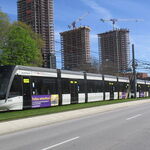ARTHUR WHITE-CRUMMEY, REGINA LEADER-POST
Updated: August 3, 2018
[...]
Reticent railways
Schneider has a pretty good idea of why support for the city’s former plan dissipated: Delays. And that’s something he blames on the rail companies.
“We had all kinds of pushback from the railroads,” he said.
Schneider said the rail companies — and especially CP — did everything they could to hold up Regina’s project, questioning cost estimates and then fighting a years-long legal battle with the city.
The rail companies lost at court, but in the meantime priorities changed and costs escalated with inflation.
“Time was the friend of those that didn’t like rail relocation,” he said.
“Given the passage of time, the costs went up and the government started to get nervous about the thing.
“It was kind of one of these things they wish they hadn’t signed,” he said of the province.
Projects were more likely to see success when the railways saw something in it for themselves. According to McGhee, the previous Red Deer line had a steep grade and unsuitable facilities. CP was eager for a fix.
“The facilities they had were really outdated for the modern life of trains, so it was a great benefit for them as well,” he said.
McGhee said the rail company never put up any resistance, and was willing to sign a contract to do design work and physically move the rails.
But the railways have been willing to make life difficult for other relocation proponents. Coun. Villeneuve in Surrey says she has faced headaches with BSFN Railway.
“They’re not anxious to move because it’s high cost,” she said.
“They may need to be forced.”
Expropriation: ‘A very extreme option’
Fortunately, there are ways to do precisely that. A municipality’s main weapon in overcoming railway opposition is the federal Rail Relocation and Crossing Act.
The Act allows the a city to submit a plan to the Canadian Transportation Agency (CTA), which can then order a rail company to remove its tracks, stop operating a line or build new facilities.
There’s two catches: The province must be on board; and the rail company must neither gain nor lose in the process.
That could mean substantial cash outlays. According to lawyer and transportation consultant Mary Jane Bennett, the railways must end up with functionally equivalent rail lines.
Bennett spent nine years with the CTA, serving on the board that actually decides those cases. She said the Act can be the best way to get relocation done, especially since it allows for a federal grant funding up to 50 per cent of the project’s cost.
She said the price tag can sometimes look quite expensive on paper, but the Act lets cities factor in the long-term benefits a rail company will reap from avoiding urban slowdowns.
“That’s huge,” she said. “If I’m cutting down their time then I’m entitled to recoup that operating efficiency over a 15-year period, which is a large amount… That will be deducted from whatever the cost is.”
Bennett kept repeating the same advice: Use the Act, and make sure to consider those savings before giving up on a relocation plan.
“At least explore that before you write off the project,” she said.
Regina went down that path in Schneider’s day, using the Act in its battle against the rail companies and winning CTA approval. Fougere hopes he won’t have to use it again — or at least not its expropriatory powers.
He called that “a very extreme option.”
“We fully hope and expect and anticipate a fair amount of cooperation and discussion,” said Fougere. “When we get to the end we’ll see, but I don’t envisage using that kind of an Act… I just don’t see it in the cards.”
Not in my backyard
Another pitfall awaits the city that dares move its rail lines: They have to go somewhere else.
That was a major challenge for Surrey’s project.
Villeneuve said there was public backlash to a draft design that would have moved the rail line from the waterfront to a corridor in the city’s east. Nearby residents opposed that idea, and the councillor and her allies had a “reaction” to deal with.
“Unless you have a location where you’re going to put that rail, where it’s not going to affect other residents, you’re going to a have a scene on your hands,” she said.
Decades ago, Regina’s relocation plan courted similar outcry from residents and councillors in the city’s northwest, the spot slated to host realigned railways. In January 1990, about 100 people gathered at Michael A. Riffel High School to make their opposition known.
“Who wants to wake up to the bang of a train running into another train or a chemical spill?” asked a Lakewood resident at the time, according to a Leader-Post article.
Schneider said new candidates inevitably rode that wave of outrage to election, turning council away from an idea it had once supported. He thinks the same thing will happen this time if Regina can’t find a route that satisfies all corners of the city.
“I have no doubt in my mind that there will be someone opposing it just for the sake of getting further recognition,” he said.
But Fougere said that’s one way this time is different. The two lines he’s targeting pass almost entirely through industrial areas, with one running through Eastview and the other brushing up against Northeast Regina. He said it would be much easier to keep them far from residential areas.
He said it might involve discussion with the Rural Municipality of Sherwood to ensure the city gets it right.
“We would look where there’s any possible rights of way that exist already and that would be a logical place to look,” he said.
“If it’s relocation then of course we’ll talk to all the partners to see what could be done.”
‘The only way to go’
Asked to handicap Fougere’s chances of fixing the Ring Road crossing, Schneider said it’s little better than a coin toss.
“I’m going to say 55/45 that we’ll see something positive there,” said the former Regina mayor.
But Fougere said he’s learned the lessons of the past. He said the main one is simple: “Don’t do what we did last time.”
He said it will be “critical” to get a firmer funding arrangement in place before moving forward with a plan — whether it’s relocation, an overpass or an underpass. He said an existing bilateral agreement between the province and the feds will make that easier than it was in Schneider’s day.
“That kind of framework was not necessarily in place back then. That’s why I think there’s more clarity,” he said.
“Now it’s much more difficult to withdraw from a project.”
That might help keep willing partners from backing out later, but Fougere will have to get financial support first. And Bennett, McGhee and Villeneuve have advice about how he should do it.
Villeneuve said he’ll need to start lobbying early. Supporters will need to craft “a good solid plan” and find out how to present relocation in a way that avoids public backlash.
“You have to be pretty clear and careful when you go into public consultation,” she said, “because that can derail it.”
Bennett said Fougere will have to make pitches to each level of government focussing on how relocation will tie into their priorities: GDP growth, faster transportation, boosts to tourism, environmental protection.
She said the city should nail down a route quickly and involve residents at every step of the way.
“Keep everything public,” she said. “Set up a website to keep people apprised of how this is proceeding, to promote it. It’s easy to promote because it’s promoting Saskatchewan.”
The best guide could be McGhee. His plan was the big success, after all. Everything seemed to fall into place at once.
The rail company didn’t fight back. The rural region surrounding Red Deer played along too. Money was available. The Alberta government had launched a program to build highway bypasses, McGhee said, and he was able to tie relocation into it. Ultimately, the province paid 90 per cent of Red Deer’s relocation costs.
Was he just lucky? Maybe, but it took him his whole career as mayor and careful negotiation to get to that point. His advice to Fougere: Be persistent. He says Regina’s mayor will have to sell everyone on the benefits of relocation and the costs of inaction.
“I think they have to outline the pluses,” he said. “Our traffic can move through without waiting, so you’re saving on time for your taxpayers, you’re saving on fuel costs.”
That’s just the beginning, he said. Think pollution, delays for emergency vehicles and slowdowns for the railways themselves.
If Fougere and his administration can lay that out in detail, McGhee thinks the answer will be clear.
“When you look at the long term, the only way to go is to relocate.”






